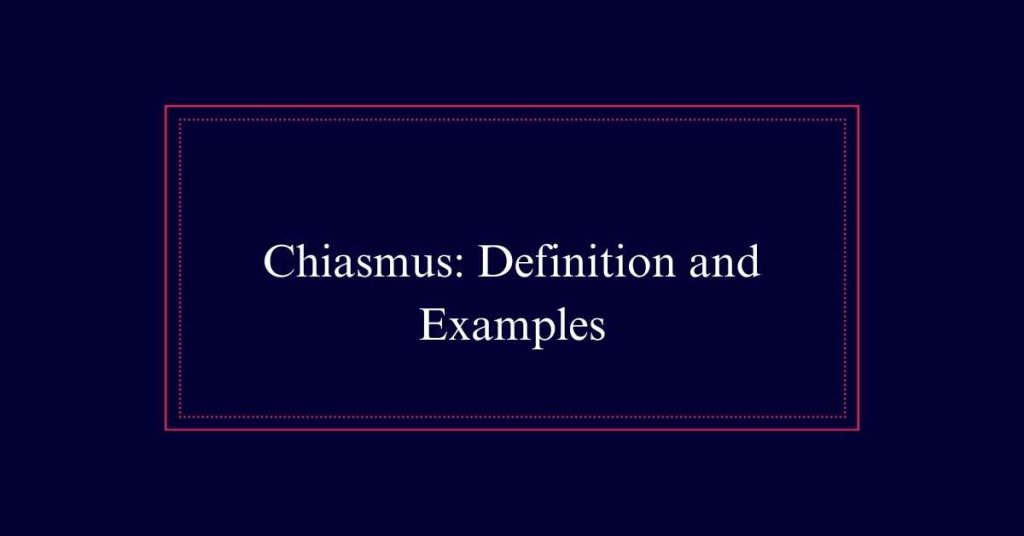Chiasmus: Definition and Examples
Chiasmus is a literary device where two clauses are structured in reverse order to create a mirrored effect. It enhances writing by adding depth and elegance through the precise mirroring of words or concepts.
Originating from the Greek term for ‘crossing,’ this technique has been used by philosophers like Plato and appears in various forms of literature, including Shakespeare’s works and the Bible. For example, “She went to the city, to the town went he” is a classic instance. This structure not only adds rhythm but also reinforces the message, offering a rich tool for effective communication.
What Is Chiasmus?
Chiasmus is a literary device where words or concepts are reversed in a sentence or phrase. It involves writing two similar clauses but in reverse order. This creates a mirrored structure that adds depth and elegance to the writing.
For example, ‘She went to the city, to the town went he.’ The parallel words and inverse structure make the sentence memorable and impactful. Chiasmus is commonly used in rhetoric and poetry to enhance the style and structure of the text.
Greek Origins of Chiasmus
Originating from the Greek word for crossing or X-shaped, the concept of chiasmus has deep roots in ancient rhetoric and literature. The Greeks used chiasmus to create balance and emphasize important ideas. This technique was not just for elegance; it was a powerful tool for persuasion and clarity.
| Greek Term | Meaning |
|---|---|
| Χ (Chi) | Cross or X-shape |
| Chiasmus | Criss-cross pattern |
| Rhetoric | Art of persuasion |
| Literature | Written works |
Ancient Greek philosophers and writers, such as Plato and Aristotle, often employed chiasmus in their works. This rhetorical device allowed them to present arguments in a more compelling and memorable way. Its usage spread from Greece to Rome, influencing Western literature profoundly.
Structure of Chiasmus
The structure of chiasmus relies on the precise mirroring of words or concepts to create a balanced and impactful statement. This mirroring is often X-shaped, where the second half of the statement inverts the order of elements from the first half.

The core idea is to have two parallel clauses that reflect each other in reverse order. For example, “She has all my love; my heart belongs to her” demonstrates this structure. The reversal of word order enhances the emphasis and draws attention to the connection between the two clauses.
This balanced arrangement not only adds rhythm but also reinforces the message, making it memorable and persuasive.
Elements of Chiasmus
Understanding the elements of chiasmus helps in crafting sentences that are both impactful and memorable. Key elements include parallel words and an inverse structure. This means that words or concepts are mirrored in reverse order.
Each part must be relevant to a single topic to maintain coherence. The mirrored layout is essential for clarity and emphasis. For instance, Mary Leapor’s ‘An Essay on Woman’ showcases effective use of chiasmus.
Such elements enhance the linguistic style, making the sentence structure more engaging. By focusing on these elements, writers can create a balanced and rhythmic flow, thereby enhancing the overall impact and memorability of their prose.
Literary Examples of Chiasmus
Numerous literary works utilize chiasmus to enrich their textual rhythm and depth. For example, in Shakespeare’s ‘Othello,’ the line ‘But O, what damned minutes tells he o’er who dotes, yet doubts, suspects, yet strongly loves,’ beautifully demonstrates chiasmus. This structure highlights the internal conflict of Othello’s emotions.
Similarly, John F. Kennedy’s famous quote, ‘Ask not what your country can do for you—ask what you can do for your country,’ employs chiasmus to emphasize civic responsibility.
Another instance is found in the Bible, in Matthew 19:30, ‘But many that are first shall be last; and the last shall be first,’ underscoring the reversal of fortunes.
Chiasmus in Rhetoric
Chiasmus serves as a powerful tool in rhetoric, enhancing persuasion and impact through its mirrored structure. This rhetorical device allows speakers and writers to emphasize their points by inverting the order of words or phrases in consecutive clauses. By creating a balanced and memorable pattern, chiasmus helps to reinforce key messages and make arguments more compelling.
Politicians and orators often use chiasmus to leave a lasting impression on their audience. For example, John F. Kennedy’s famous line, ‘Ask not what your country can do for you — ask what you can do for your country,’ employs chiasmus to instill a sense of civic duty. The reversed structure captures attention and underscores the importance of the message, making it both memorable and persuasive.
Enhancing Writing Style
Employing chiasmus in writing can greatly refine and elevate the stylistic quality of your prose. This literary device brings balance and symmetry, making sentences more engaging and memorable.
By reversing the order of words or concepts, chiasmus introduces a sophisticated structure that enhances readability. It adds a layer of polish to your writing, making it more appealing to readers.
Chiasmus also helps in emphasizing particular points, ensuring they stand out. This technique is particularly useful in persuasive writing, where impact and clarity are essential.
Through its mirrored layout, chiasmus can transform simple sentences into powerful statements, thereby improving overall communication effectiveness.
Deepening Ideas With Chiasmus
Reversing concepts in chiasmus can deepen the meaning of ideas by highlighting contrasts. This technique uses mirrored structure to emphasize differences and enhance understanding. By focusing on the interplay between opposing concepts, writers can create a more profound impact.
Here are four ways chiasmus deepens ideas:
- Emphasizes Contrast: Highlighting opposite ideas draws attention to their differences.
- Enhances Clarity: Repetition in reverse order can make complex ideas easier to understand.
- Strengthens Argument: Contrasting statements can make arguments more compelling.
- Illustrates Balance: Demonstrates the equilibrium between two contrasting ideas.
Creating Rhythm With Chiasmus
While chiasmus deepens ideas through contrast, it also creates a rhythmic pattern that enhances the flow of writing. This rhythmic quality is especially prominent in poetry, where the mirrored structure of chiasmus swaps nouns, verbs, and adjectives to create a balanced, harmonious effect.
The repetition and inversion of elements not only make the text more engaging but also add a formal or even old-fashioned tone. However, the rhythmic impact of chiasmus is not limited to poetry; it can also elevate prose by giving it a polished and sophisticated feel.
Impact of Chiasmus on Writing
Chiasmus frequently enhances the impact of writing by adding depth, rhythm, and memorability. This literary device is particularly effective in the following ways:
- Enhances Persuasion: By mirroring ideas, chiasmus reinforces arguments, making them more compelling.
- Adds Emphasis: The repetition of structure highlights key concepts, ensuring they stand out.
- Improves Clarity: By juxtaposing contrasting ideas, it clarifies complex concepts.
- Creates Rhythm: The balanced structure of chiasmus imparts a pleasing rhythm, making the text more engaging.






